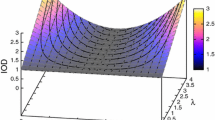Abstract
Consider a collection of 802.11 access points. Each serves as the gateway to the Internet for clients in its WiFi cell. These cells have an arbitrary interference pattern, and reception at a client may be corrupted by transmissions nearby. The popularity of WiFi has made such dense deployment increasingly common. As interference can seriously degrade performance, there is much interest in optimizing the configuration of these cells. One factor to consider in optimization is channel share, defined as the useful fraction of channel bandwidth that an access point gets when there is downlink traffic saturation. Interference affects channel share on the sender side through carrier sensing and transmission deferral, and on the receiver side through collisions, which result in exponential backoff and retransmission. There exists a simple, “back-of-the-envelope” (BoE) technique to model the impact of pairwise sender-side interference. This paper tackles the harder task of determining the impact of receiver-side and non-pairwise sender-side interference. It proposes a technique for modeling the channel share of wireless links, and the accuracy is demonstrated with Qualnet simulation.











Similar content being viewed by others
References
Meraki networks. http://www.meraki.com/. Accessed 20 June 2011.
Qualnet simulator. Available from http://www.scalable-networks.com/. Accessed 20 June 2011.
Akella, A., Judd, G., Seshan, S., & Steenkiste, P. (2005). Self-management in chaotic wireless deployments. In: MOBICOM, Cologne, Germany, pp. 185–199.
Bejerano, Y., Han, S.-J., & Li, E. L. (2004). Fairness and load balancing in wireless LANs using association control. In: MOBICOM, Philadelphia, PA, pp. 315–329.
Das, S. M., Papagiannaki, K., & Tay, Y. C. (2009). SWARM: The power of structure in community wireless mesh networks. In: CoNEXT, Rome, Italy, pp. 49–60.
Durvy, M. (2007). Modelling the IEEE 802.11 protocol in wireless multi-hop networks. EPFL.
Garetto, M., Salonidis, T., & Knightly, E. W. (2008). Modeling per-flow throughput and capturing starvation in CSMA multi-hop wireless networks. IEEE/ACM Transactions on Networking, 16(4), 864–877.
Jain, K., Padhye, J., Padmanabhan, V. N., & Qiu, L. (2003). Impact of interference on multi-hop wireless network performance. In: MOBICOM, San Diego, CA, pp. 66–80.
Jardosh, A. P., Ramachandran, K. N., Almeroth, K. C., & Belding-Royer, E. M. (2005). Understanding congestion in IEEE 802.11b wireless networks. In: Internet measurment conference, Berkeley, CA, pp. 279–292.
Kashyap, A., Ganguly, S., & Das, S. R. (2008). Measurement-based approaches for accurate simulation of 802.11-based wireless networks. In: MSWiM, Vancouver, British Columbia, Canada, pp. 54–59.
Kauffmann, B., Baccelli, F., Chaintreau, A., Mhatre, V., Papagiannaki, K., & Diot, C. (2007). Measurement-based self organization of interfering 802.11 wireless access networks. In: INFOCOM, Anchorage, AK, pp. 1451–1459.
Anil Kumar, V. S., Marathe, M. V., Parthasarathy, S., & Srinivasan, A. (2005). Algorithmic aspects of capacity in wireless networks. In: SIGMETRICS, Banff, AB, Canada, pp. 133–144.
Liew, S. C., Kai, C. H., Leung, H. C. J., & Wong, P. B. (2010). Back-of-the-envelope computation of throughput distributions in CSMA wireless networks. IEEE Transactions on Mobile Computing, 9(9), 1319–1331.
Marinier, P., & Cuffaro, A. (2006). Power control in 802.11 wireless LANs. In: VTC Fall, Montreal, QC, pp. 1–5.
Mhatre, V., Papagiannaki, K., & Baccelli, F. (2007). Interference mitigation through power control in high density 802.11 WLANs. In: INFOCOM, Anchorage, AK, pp. 535–543.
Mishra, A., Shrivastava, V., Agrawal, D., Banerjee, S., & Ganguly, S. (2006). Distributed channel management in uncoordinated wireless environments. In: MOBICOM, Los Angeles, CA, pp. 170–181.
Qiu, L., Zhang, Y., Wang, F., Han, M. K., & Mahajan, R. (2007). A general model of wireless interference. In: MOBICOM, Montréal, QC, Canada, pp. 171–182.
Ramachandran, K. N., Belding-Royer, E. M., Almeroth, K. C., & Buddhikot, M. M. (2006) Interference-aware channel assignment in multi-radio wireless mesh networks. In: INFOCOM, Barcelona, Spain, pp. 1–12.
Reis, C., Mahajan, R., Rodrig, M., Wetherall, D., & Zahorjan, J. (2006). Measurement-based models of delivery and interference in static wireless networks. SIGCOMM computer and communications review, 36(4), 51–62.
Shi, J., Gurewitz, O., Mancuso, V., Camp, J., & Knightly, E. W. (2008). Measurement and modeling of the origins of starvation in congestion controlled mesh networks. In: INFOCOM, Phoenix, AZ, pp. 1633–1641.
Sundaresan, K., & Papagiannaki, K. (2006). The need for cross-layer information in access point selection algorithms. In: Internet measurement conference, Rio de Janeriro, Brazil, pp. 257–262.
Tay, Y. C., & Chua, K. C. (2001). A capacity analysis for the IEEE 802.11 MAC protocol. Wireless Networks, 7(2), 159–171.
Wong, S. H. Y., Yang, H., Lu, S., & Bharghavan, V. (2006). Robust rate adaptation for 802.11 wireless networks. In: MOBICOM, Los Angeles, CA, pp. 146–157.
Acknowledgment
Many thanks to Dina Papagiannaki, who hosted Tay’s sabbatical at Intel Research, Cambridge, where a simplistic version of the channel share model was first conceived.
Author information
Authors and Affiliations
Corresponding author
Rights and permissions
About this article
Cite this article
Zhao, Z.W., Tay, Y.C. A model for calculating channel share of 802.11 access points with overlapping wireless cells. Wireless Netw 17, 1581–1593 (2011). https://doi.org/10.1007/s11276-011-0365-4
Published:
Issue Date:
DOI: https://doi.org/10.1007/s11276-011-0365-4




